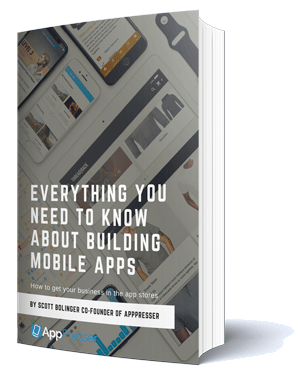How to Use a Book as Content Marketing for Your Online Business

Content marketing can be the key to building the following you want for your business. You can use YouTube, blog posts, social media, and a number of other ways to get more people to know who you are so that they trust you and are more likely to purchase from you.
Today we’re going to look at one of the parts of content marketing that feels more daunting to many, the eBook. If you’re already blogging, or even writing video scripts, then it’s not that much more work to take some of that content and turn it into an eBook.
By the end of this post you will be equipped to get started with an eBook for your content marketing.
Getting the Content
There are two main ways to get content for your eBook. First curation, taking existing blog posts or video scripts and using them as the backbone of your content efforts. Second, write it from scratch and then use the content in other aspects of your content marketing.
Let’s dive into both methods.
Curation

If you’ve been writing for a while, then you have a wealth of content on your site. The traffic on your blog will show you which types of content are most interesting to your readers.
To dig into your content head over to your analytics tool and find the top 20 posts over the course of the last six months. If you have enough data to get a year of user feedback, then use it. I generally consider a single quarter to be the minimum needed to start to see what readers are interested in.
Yes, this does favour the posts that have been around longer, so take a look at some of your most recent posts as well to gauge how fast they’re getting traction compared to older posts. Make sure you factor those in as you move on to the next step.
Collect your top 20 posts and write a brief summary of the content in a single document. Now, start grouping them together by theme. If a post overlaps a few themes, put it in multiple sections.
The goal is to start to get an idea of what content is popular and to see how you’ve covered it already. You may find that you’ve got 3 groups of posts and that they all fit into a single idea with three different sections or you may find that you have three short eBooks covering different aspects of your business.
Once you have some sections, take a look at your site to see if there are other posts you’ve written around the same topics. Have you covered more content related to the popular posts that didn’t find the same traction. Use these as research for your book and at the same time see about tweaking these other articles so that they can come to the attention of your readers. Can you tweak the popular posts to link to the less popular ones to increase their traffic?
Writing From Scratch
Your other option is to write from scratch based on what you know now or what you’re interested in. We did this at AppPresser when we started writing about mobile browsing being the present not the future. That started as a book that we’re using as a call-to-action with some of our marketing efforts. It continued as we released 7 posts corresponding to chapters from the book.
Scott wrote this book based on his knowledge from working with customers at AppPresser since 2013. Scott took the common questions that customers ask and answered them in an eBook that we converted to blog posts.

If you’re looking at writing something from scratch, that is the place to start…with the questions that people are asking you about your area of expertise. Write down your top 20 questions and then write an outline that will answer the questions. Then, group them into themes that relate and you’ve got an outline for your book.
Rewriting and Research
Once you have a working outline, it’s time to start digging in to the content deeper. This begins with deciding what type of book you’re planning on writing? Are you writing something that’s centered around a marketing piece for the company, or are you hoping that it gains you recognition with readers far and wide so you can do a podcast tour and sign copies of the book? Each type of book has different writing requirements and will require a different approach with this step.
Marketing Focused Book
If you’re going to write a book focused on marketing for your site and as a call-to-action to use when you’re directing people to your site, then you have a bit less work to do as you write the book. Unlike writing a more traditional book, you can write this type of book solely out of your experience.
You can drop some of the fact checking and citation work that you’ll do with a traditional book. You can also be less formal in your language without throwing readers off.
None of this means that you can skimp on the quality of the content. You need to make sure that you follow through with solid helpful content for your readers. They need to leave your book feeling like it fulfilled the promises you made in your call-to-action on the site.
If you miss fulfilling this promise, the readers are unlikely to stick around long enough to become customers. That misses the entire point of the book.
Writing for Wider Recognition
If you’re primary goal is to write a more traditional book then it’s time to take your outline and start researching. You’ll want to grab web articles, scientific journal articles, survey’s and even some other books to support your writing.
When I do this I start a collection of items in DEVONthink and keep adding to it until I feel like most of the content I’m coming across is something I already knew or already read and have citations for. It’s also important in this process to track back to some of the original research cited online and make sure that the paper matches up with what has been written about it.
As an example, one common claim you’ll see is that multiple monitors increase productivity1. When you read the research paper that most people cite you find out that the task was to take information in a document and enter it into a spreadsheet. No one works like that, they all have Twitter, Slack and many other distractions in the way of getting work done. If you want to say that multiple monitors increase productivity in the workplace, you’re going to need to dig deeper and find a study that tests under standard workplace distractions where the worker is free to be distracted by the other things spread around their monitors.
You’ll need to provide a proper bibliography for your work to go with this research. Like above where I added a footnote to cite the study I’m talking about, you’ll need to include footnotes to the research that backs up your claims.
The Act of Writing
Once you’ve exhausted the research avenues available to you, it’s time to start the act of writing. Over the number of books I’ve written the best app for writing is Scrivener. Best of all it’s available on Windows, macOS and iOS. All of them can work with the same files and even iOS has every feature you’ll need to get the writing portion done.
With your research collected, you can drop it all in Scrivener along with your outline and start to flesh out the outline into something that’s starting to resemble a book.
One of my favorite features of Scrivener is the side-by-side writing you can do if you import your research. I often put my research or outline up on one side, and then put the words I’m writing on the other. This lets me get through thousands of words in a day while keeping focused on the right content2.

If Scrivener is out of reach, then any word processor will do. The most important part is to get the information out of your head and into a place where it can be shared with the customers you want to reach.
Editing Your Book
With your book in hand it’s time to start the editing process. Here there are a few options. The cheapest, and still fairly effective, way is to get in touch with your email list about the book and ask if there are 10 people that are willing to join the launch team. Usually you’ll give them some perks in addition to an advanced copy of the book3.
If you go this route, export your Scrivener document and put it on Google Docs then invite the people that are willing to read it early. As they find issues, update the Docs file. Then you can export it for formatting and publishing.
The other way to go is to hire a professional editor, but you need to be sure you’re getting the right type of editor. There are two main types of editors for this type of project.
- Content editor
- Copy editor
A content editor will read through your work and tell you if the book flows well. Do your ideas connect together? Does it make sense or are there holes in the content that will confuse your readers. They may look at the spelling and grammar, but their main focus is to make sure that your content is well organized and clear.
A copy editor won’t do the same work on the substance of your book, they’ll make sure that you’ve spelled things properly and that your grammar and punctuation is correct.
There is no reason that you can’t use a launch team for the content editing, and then pay a professional editor for the copy editing. In fact one good reason to do that is to get your email list invested in your work so that they are more likely to talk about it when it launches.
Publishing your eBook
Now that you have your book written it’s time to publish it. Looking for some type of traditional publishing is outside of the scope we can cover today so we’re going to focus on how to get a final product that you can be proud of.
Formatting
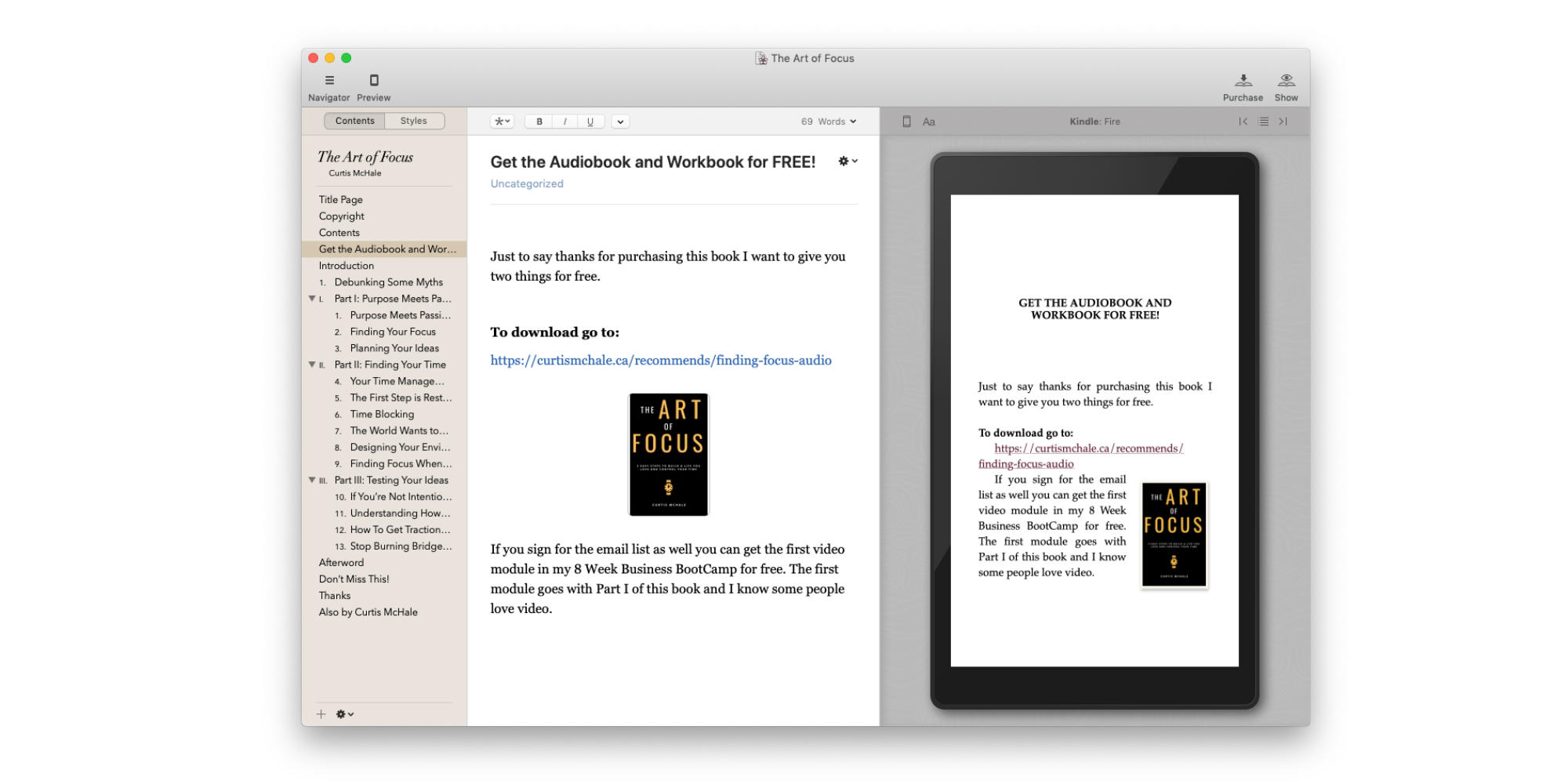
While Scrivener has some good export settings, they always seem like a black art. I’ve published 7 books on Amazon and every single time it took days to get Scrivener to format my book properly. Yes, you could also go with InDesign or another full-fledged print design program, but those are as big a dark art to learn as Scrivener so let’s look at some options anyone can understand.
There are a few options that make formatting your book a breeze. If it’s a text heavy book and you’re not specific about how images are formatted then Vellum is one of the best options around. Unfortunately Vellum is macOS only but that doesn’t mean there are no other options for Windows and Linux users.
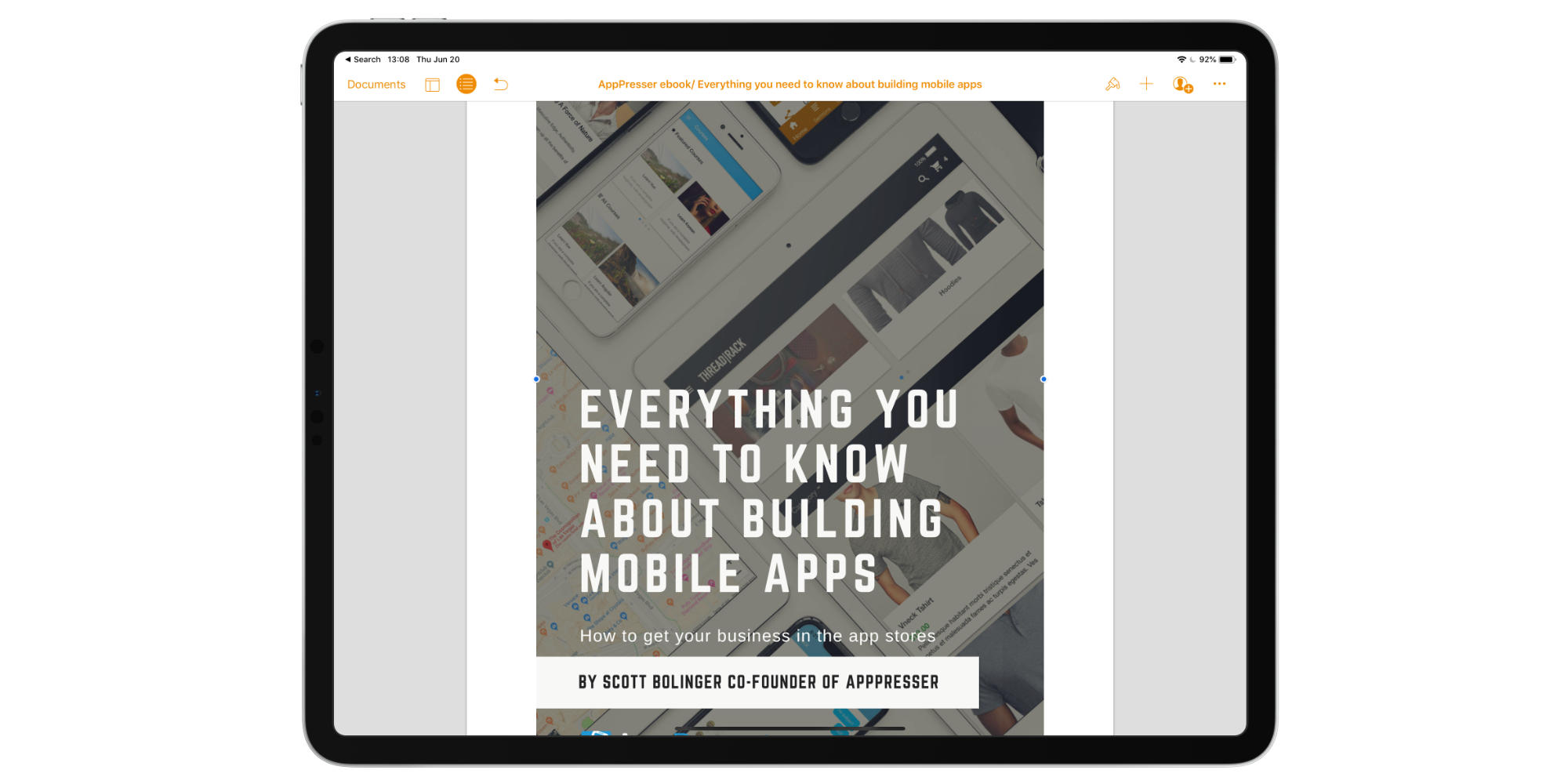
Another solid Mac option is to use Pages. We used it for our recent book Everything You Need to Know About Building Mobile Apps. I formatted it in Pages on my iPad, in large part while my daughter figure skated. Pages is free and the iOS version is as good as the Mac version. They’ll even sync your documents back and forth if you save them in iCloud. It was much easier to layout our book with it’s images and formatting in Pages than it was to get exactly what we wanted out of Vellum.
If you’re not an Apple person, Pressbooks is one of the better options out there for formatting your books. You pay a one-time fee of $19.99 to format a book and then you get to use their software to build a nicely formatted eBook. If you want to add a print book then you’ll need to spend $99 for a single book.
Either of these three options will give you the tools you need so that you can produce a book you can be proud of.
The Makings of a Good Cover
As your formatting your book, you need to be thinking about a cover. Your cover is the first thing people see when they’re thinking about downloading or purchasing your book, so it needs to sell your book. Note I said sell, because a good selling cover doesn’t have to be an artistic dream.
First, your title needs to be catchy and readable at thumbnail size. Note in the screenshot below how well the dark text stands out against the yellow background.

Here the title is big and bold, and it’s in contrasting colours. You can see this again with all the business books below. Not a single one is hard to read.
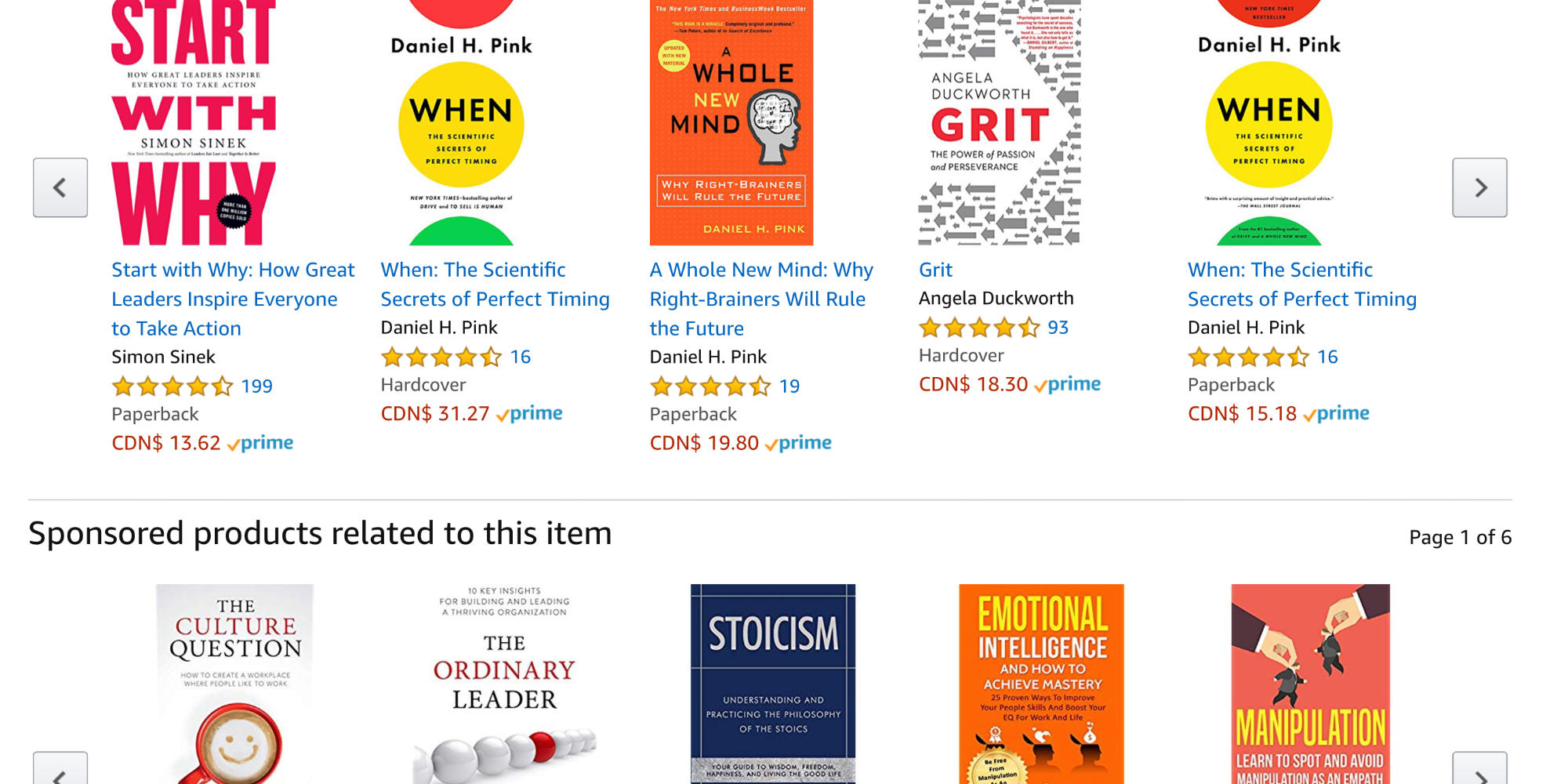
When I build the covers of my books I take a screen shot like the one above with all the different business books and size my cover to match. If I can’t tell what it is then the cover isn’t right, no matter how pretty it is.
As you go through this design process, you also need to think about the title of your book. This is another place where it’s good to survey any email list or Twitter followers you have. Drop your prospective titles into a Google Form and ask for votes on which one is the best. You can see one of my books title and subtitle options below.
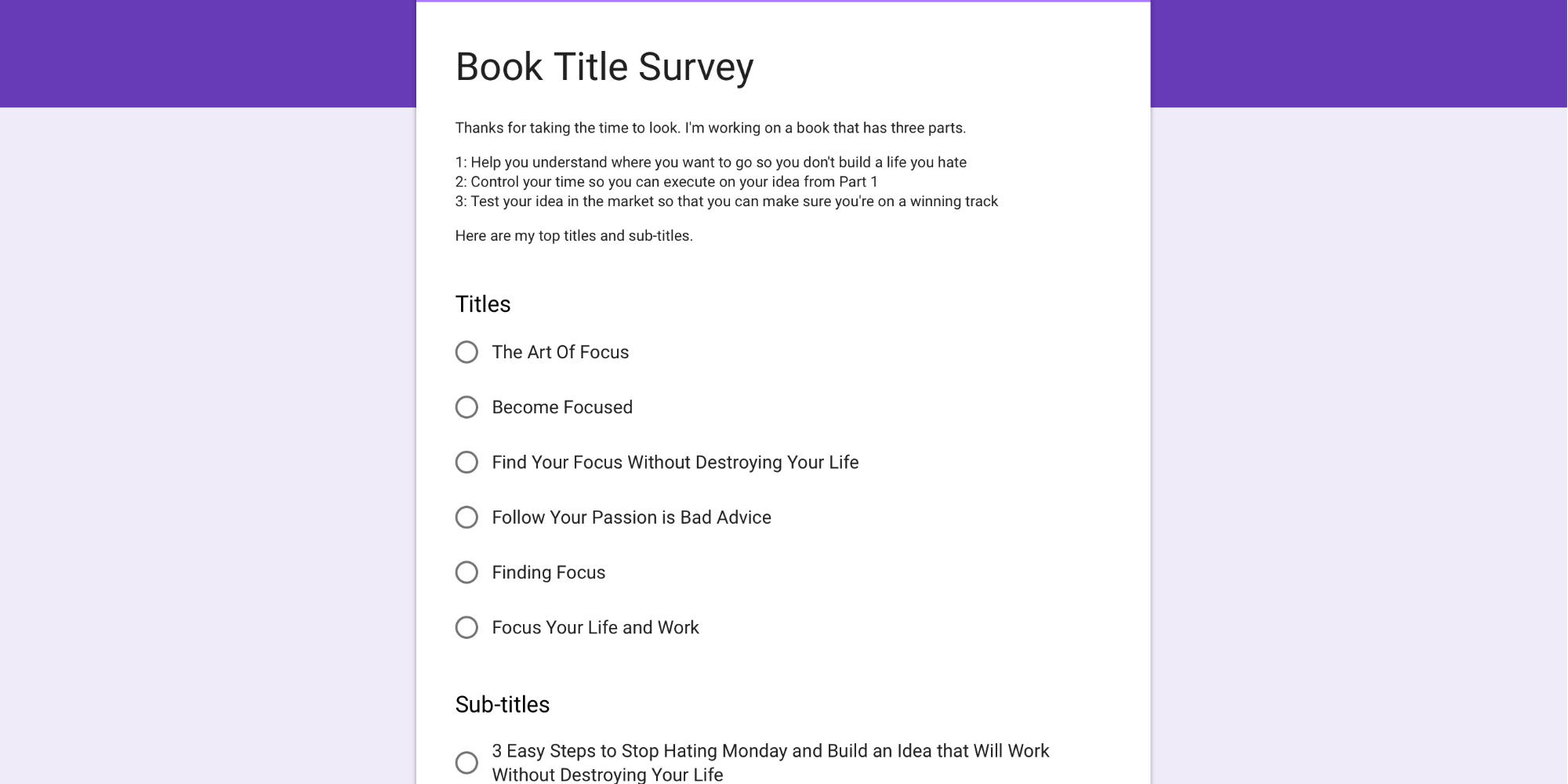
Remember, by asking your email list, you’re getting them invested in the process which means they’re more likely to talk about the book as it comes out. Take every opportunity you can to do this.
Where to Publish Your Book?
Next, where do you publish your book? If you were only going for an internal marketing piece, then add it to your email account as a call-to-action and leave it there. I always like to tell anyone already on my list about it too so that they don’t find some extra thing that new people get but they don’t have. It always feels to me like doing this punishes your long term supporters.
You can also choose to sell a copy of your book if you’re trying to use it as a wider marketing piece. You can use a self-hosted store like WooCommerce or Easy Digital Downloads or you can choose to use a hosted platform like Gumroad. The advantage to hosting it yourself is that you directly own the relationship with your customers, and you often end up paying less in transaction and hosting fees. The downside is that if something goes wrong with your store, you have to fix it or pay someone to fix it. If Gumroad has trouble, they have people that fix it so you don’t have to spend hours trying to figure out what’s going on.
Since we’re going to go with the self-publishing route, we’re going to publish on Amazon. Amazon pushes you to publish with them only by providing some of it’s best marketing tools only to books that are exclusive to Amazon. You can’t offer your book as a free book during launch if you’re not publishing exclusively with Amazon. This “book for free” can be a great sales tool because it will get you in a bunch of lists as an “also bought” book which will help get your book in front of other people shopping on Amazon.
The saving grace is that your Amazon exclusivity is only for 90-days then you can take your book out of Amazon exclusivity and publish it elsewhere.
In Canada I publish my books on Kobo as well because they bring access to Libraries in both digital and physical form. I’ve sold a number of my books into Libraries at the requests of my readers. The other great thing about Kobo is that they don’t do any type of exclusivity contract. They’re happy to publish your book, and it’s fine to have it published elsewhere.
Marketing Your Book
While we’re talking about marketing your book at the end of this post, you need to think about it from the beginning because it starts as soon as you start writing the book. I survey my email list right away about the content of the book so that they have input. If I’m working on a marketing book, I’ll ask them what marketing methods they want to hear about for their business.
At AppPresser, Scott wrote our book and then we published it basically word for word on the site while leveraging the book itself as a call-to-action on the posts. Yes, you can piece together the book from the site4 but many people opt to get it in one shot as a PDF to save the time.
I’ve often taken two or three pieces of information out of each section of the book I’m writing and write blog posts around that content. I follow each post up with a call-to-action to the book so that users are encouraged to purchase it because they found the content they just went through helpful.
Whatever you do, don’t assume that just because you wrote a book and linked to it once it will get any traction. You need to continually follow up with it and talk about it so that people that are new to your content find it. You need to continue to leverage it to extract all the value that your book has to offer, after all the time you’ve put into it.
If you take the time to be intentional with your eBook, you can turn it into a great lead generator for your business.
Featured image: Mike Bird from Pexels
- Productivity and Multiscreen Displays ↩
- If you’re looking for more Scrivener tips and training I recommend Scrivener Classes ↩
- Perks could include a video call or a set of stickers or free printed and signed copies of the book. ↩
- We even provided a helpful table of contents with links in each post so you don’t have to hunt for the content ↩

